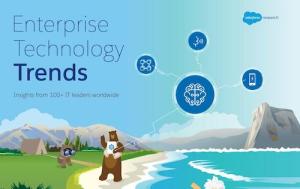Top 10 Enterprise Technology Trends Reported by 100+ IT Leaders



Discover what 100+ IT leaders are saying about the top 10 enterprise technology trends that are shaping the future.
Salesforce EMEA
Enterprise technology trends will shape the landscape of the new normal, the next normal, and beyond.
In an age of hyper-acceleration, enterprise technology is helping organisations of all sizes explore new frontiers, reinvent their businesses, and unlock their true potential. Any business can now be a game-changing one, and we never know where the next innovative idea might come from.
Insights from Over 100 Global IT Leaders
Discover which trending technologies will have the greatest impact on businesses in the next five years.

To get a clearer picture of where we’re heading, we surveyed enterprise IT leaders from around the world. Here’s what’s impacting their organisation, what they’re preparing for, and what they think the future holds.
The top 10 enterprise technology trends
These enterprise technology trends offer a glimpse of a bold, new world waiting on our doorstep. It’s a world where optimised experiences are the norm, learning new skills is a priority, and AI stretches the boundaries of what’s possible.
1. Customer experience
It’s no secret that the customer experience has become the focal point of the new landscape. So it’s no surprise that it tops the list of enterprise technology trends.
77% of IT leaders are increasing investment in customer experience.



In an age when omnichannel experiences have raised the bar for the customer journey, offering a ‘good’ customer experience is not enough. Customers now expect:
- Engagement across touchpoints
- 24/7 customer service
- Robust security
- Identity management
According to our report, 93% of IT leaders say that better customer-facing technology is crucial for remaining competitive in the marketplace. Customer expectations are sky-high and only expected to grow further. Businesses need to evolve to keep up.
2. Employee experience
The employee experience has also come under increased scrutiny, as dissatisfied workers tend to be ineffective workers. The ubiquity of new personal technologies is redefining employees’ expectations of workforce technologies.
According to our report, 84% of IT leaders say that improving employee technology is crucial. Only 21% of these leaders say that their current technology maximises employee engagement and only 25% say that it maximises productivity.
Despite this, only 50% of IT leaders say that they are increasing investment in the employee experience. Whether this is due to the challenges presented by updating legacy systems, insufficient budgets, or competing priorities, there’s a stark disconnect between what IT leaders need to do and what they’re actually doing.
3. Developer experience
There’s a shortage of developer talent and a huge demand for their time. This means that the ‘innovation pipeline’ is clogged with uncompleted projects. In fact, 72% of IT leaders say that project backlogs are preventing them from completing strategic projects.
Upskilling and re-skilling the workforce can solve some of these issues, and low-code developer platforms offer another solution. For example, The Salesforce Developer Channel lets users create apps by simply dragging and dropping components, with no coding knowledge required.
4. Mobile technology
It’s been clear for a while that mobile technology would be important for thriving in the new climate. It shouldn’t be too surprising then that 99% of IT leaders believe that businesses must be mobile-enabled to survive.
But what is surprising is that only 44% say that mobile technology is a high priority. Perhaps that’s down to a lack of skills (only 29% say they have advanced mobile technology skills) or thought leadership (only 20% say that they have a completely defined mobile strategy).
Whatever the roadblock is, businesses need to address it quickly. A whopping 74% of business leaders predict that a lack of mobile access to data, apps, and content will slow productivity in 2025.
5. System Integration
The average enterprise now uses 900 different applications, but IT leaders estimate that only 29% of their applications are integrated. Finding a way to connect processes, boost productivity, and create more cohesive experiences by integrating systems has become a high priority for 55% of respondents.
It’s not just IT leaders who desire more connected processes. According to our survey, 76% of customers say that connected experiences are very important for winning and retaining their business.
Still, there are obstacles that inhibit integration. 69% of IT leaders say that lack of integration causes a disconnected customer experience at their company. 71% of IT leaders say integration projects are too time-consuming and expensive. Addressing these obstacles for full integration is one of the keys to success in the customer-focused future.
6. Artificial intelligence
AI is already shaking up the landscape. It powers everything from commercial flights and ride-sharing apps to smart vehicles and voice assistants. Its ability to act as a catalyst for change is clear. In fact, 83% of IT leaders say that AI is transforming customer engagement.
69% of IT leaders say that AI is transforming their businesses.



Its multitude of potential applications, however, seems to have presented a challenge to IT leaders. Only 7% say that their AI strategy is completely defined. Finding a way to harness the power of AI may be difficult for many organisations. Considering that only 10% say that their artificial intelligence skills are advanced.
7. Voice technology
Like AI, voice technology should find plenty of new applications in the emerging landscape, particularly in customer service, sales, and marketing. And also like AI, companies are struggling to develop effective voice-technology strategies and skill sets. Only 22% say that voice technology is a high priority, and only 14% say that their strategy around it is completely defined.
It looks like this is headed for a correction, though. We found that 68% of IT leaders think that voice technology will be an important part of their business within just two years. And with so many departments benefiting from voice technology, it will certainly find its way into new and surprising places.
8. IT staff learning and development
Technology will radically reshape the future. But companies that don’t have the right skills to capitalise on the latest innovations could get left behind. Highly skilled IT employees are in short demand, so forward-thinking companies are focussing on internal IT learning and development programmes.
Although IT learning/development made the list of enterprise technology trends, only 41% of respondents say that it’s a high priority.
79% of IT leaders say acquiring good IT talent has never been harder.



Businesses that focus on their internal IT learning and development programmes will be in much better shape to handle the challenges. They also capitalise on further opportunities in the accelerating landscape.
9. Blockchain
Blockchain is a new enterprise technology trend, and only 22% of IT leaders have identified a blockchain use case. But more and more businesses are starting to see the future potential in cryptographic technology. In fact, 50% of IT leaders plan to increase their investments in blockchain over the next couple of years.
Some companies have gotten quite creative with their applications, like:
- Turning to blockchain to tackle potential voter fraud.
- Streamline commodities trading.
Monetizing solar power and creating digital IDs.
Burger King even used blockchain to launch its own cryptocurrency in Russia. And while “WhopperCoin” is unlikely to revolutionise business, blockchain will almost certainly cause a stir.
10. Security and trust
The numbers show that security and trust are one of the enterprise technology trends that are getting more attention. Not only do 79% of IT leaders say that security and trust are high priorities, but 42% already have a completely defined strategy for security and trust. Moreover, 44% say that their skills are advanced.
This is great news for the customer with concerns around security and trust. In fact, 95% of organisations have increased their investments in security due to public concerns. With the GDPR bringing more attention to privacy regulations, building security and trust should only become more important.
Where will these enterprise technology trends take us?
When it comes to preparing for tomorrow, it looks like there’s still plenty of work to do. Many organisations seem to know where they need to go, they’re just still trying to find ways to get there.
We’re gradually moving towards a future defined by exceptional customer experiences, higher levels of security and trust, and an increased focus on building skill sets.
To hear more about how enterprise technology trends will shape tomorrow’s landscape, download the full Enterprise Technology Trends report.
Insights from Over 100 Global IT Leaders
Discover which trending technologies will have the greatest impact on businesses in the next five years.





















